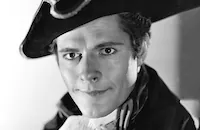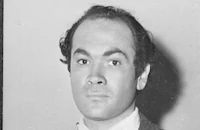The Bridge of San Luis Rey
Brief Synopsis
Cast & Crew
Rowland V. Lee
Lynn Bari
Akim Tamiroff
Francis Lederer
Nazimova
Louis Calhern
Film Details
Technical Specs

Synopsis
In 1774, in Peru, a rickety bridge that for one hundred years has spanned the gorge leading to the chapel of San Luis Rey collapses, sending five people plunging to their death. Deeply affected by the catastrophe, Brother Juniper, the pastor of the chapel, journeys to Lima in quest of why these five people were chosen to die. There Juniper visits Uncle Pio, a theatrical entrepeneur who is widely regarded as the pulse of his people. When Juniper questions Pio about the beloved Peruvian actress Michaela Villegas, Pio recalls first seeing her perform in the streets of Lima: Micheala is attracted to the adventurous Manuel, but Esteban, Manuel's morose twin brother, despises her. One day, Manuel tells Michaela that he is sailing to Spain and asks her to wait for him. After Manuel departs, Pio becomes Michaela's mentor, schooling her in acting and proper comportment. Under Pio's guidance, Michaela develops into the leading actress of the Comedia Theater. The Viceroy, bored and resentful over being exiled from Spain to the colony of Peru, becomes intrigued by Michaela and invites her to the palace. On the night that Michaela is to meet the Viceroy, Manuel returns, and she foresakes her audience with the nobleman to spend the night with him. Jealous over the Viceroy's interest in Michaela, Manuel forbids her to go to the palace and warns her that the aristocracy will make her an object of ridicule. Manuel's return creates tension between the brothers, and upon returning home one night, Manuel finds a stack of unmailed letters Michaela had written to him and a note from Esteban, apologizing for never having mailed them. Full of remorse, Esteban tries to hang himself but Manuel cuts him down and nurses him back to health. When Esteban is well, Manuel abruptly leaves for an around-the-world voyage. Soon after, the Viceroy invites Michaela to the palace again and she accepts. The Marquesa, determined to win the Viceroy for her daughter, embarks upon a scheme to destroy Michaela. When the Viceroy's guests insult Michaela by treating her as a common entertainer, the Marquesa pretends to be her friend, thus winning her confidence. Returning to the present, Pio finishes his part of the story and Juniper visits the Abbess to ask her about the Marquesa. The Abbess tells Juniper that to escape her mother's plans for her marriage, the Marquesa's daughter ran away to Spain and married a young nobleman. Lonely after her daughter's departure, the Marquesa visits the Abbess to ask for a companion. The Abbess obliges by giving her Pepita, an innocent, gentle orphan. Embittered and forlorn, the Marquesa mistreats little Pepita. When the frustrated Marquesa interrogates Pio about Michaela's relationship with the Viceroy, Pio warns her against slander. At Michaela's villa, meanwhile, the Viceroy confides to Michaela that he may be in love with her because she has awakened his interest in the Peruvian people. Later, Esteban, who is working as a scribe, warns Michaela that the Marquesa and the other aristocrats are plotting against her and produces a letter as proof. Feeling betrayed, Michaela goes to Pio for advice, and he composes an insulting song for her to sing at a gathering at the palace that afternoon. Michaela's lyrics about an old crow plotting to overthrow the court scandalizes all those present. Furious, the Viceroy orders Michaela to apologize to the Marquesa and instructs her to wear a black dress and sandals, the uniform of penitence. Although she resents the Viceroy's public humiliation of her, Michaela follows his command and visits the Marquesa. Ashamed, the Marquesa thanks Michaela for showing her the error of her ways and apologizes. That night, Manuel, now a sea captain, returns and asks Michaela to go away with him. In response, Michaela philosophizes about the impossibility of ever understanding oneself or others, and points to the transformation of the Marquesa and Esteban as proof. As Michaela and Manuel embrace, the Viceroy enters and insists that Manuel accompany him to the palace. There, after a confrontation with Manuel, the Viceroy realizes that his rival is dangerous and orders his arrest. Soon after, the Viceroy receives an order to return to Spain and asks Michaela to join him as his wife. Infuriated by Manuel's arrest, Michaela rejects his proposal. As the Viceroy plans his last trip with Michaela, a journey to a mountain village to dedicate a hospital, Michaela tells Pio of Manuel's danger and asks his help in freeing Manuel from jail. On the day of Michaela and the Viceroy's departure to San Luis Rey, Pio and his friends break Manuel out of jail. Upon learning of the escape, the Viceroy questions Pio, who recommends that he pardon Manuel or risk turning him into a martyr. After the Viceroy signs the pardon, Pio delivers it to Manuel, who is hiding in the rocks abutting the bridge of San Luis Rey. Together, Manuel and Pio watch as the Viceroy and his party arrive for their trek across the bridge. They are joined by the Marquesa, who has come to prey at the chapel with Esteban and Pepita. The Viceroy crosses to the other side, followed by Pepita, Esteban, the Marquesa and the Viceroy's aide. As the Viceroy steps onto the yard in front of the chapel, an Indian passes him and crosses onto the bridge. On the other side, meanwhile, Michaela is about to traverse the bridge when Manuel emerges from behind the rocks and kisses her. As she steps on the bridge, the span collapses, sending the Marquesa, the Indian, the Viceroy's aide, Pepita and Esteban to their deaths. Manuel and Pio watch in horror, pulling Michaela to safety at the last moment.

Director
Rowland V. Lee
Cast
Lynn Bari

Akim Tamiroff

Francis Lederer

Nazimova

Louis Calhern

Donald Woods
Blanche Yurka
Barton Hepburn

Joan Lorring
Emma Dunn

Abner Biberman
Antonio Triana
Minerva Urecal
Crew
Benedict Bogeaus
John W. Boyle
Joseph Depew
Howard Estabrook
Howard Estabrook
Carley Harriman
Arthur M. Landau
Ted Larsen
Rowland V. Lee
Reynaldo Luza
Harvey Manger
John Mescall
Charles Odds
Scotty Rackin
Dimitri Tiomkin
Herman Weissman
Maurice Yates

Film Details
Technical Specs

Award Nominations
Best Score
Articles
The Bridge of San Luis Rey
The Bridge of San Luis Rey features a deceptively simple plot. Wilder sums it up in the novel's first line, "On Friday noon, July the twentieth, 1714, the finest bridge in all Peru broke and precipitated five travelers into the gulf below." The story of the bridge collapse, and the five fated to die there, is told in flashback. A Franciscan missionary who witnessed the tragedy tries to makes sense of why it happened. Among the five killed are: singer Micaela (Lynn Bari), her Uncle (Akim Tamiroff), twin brothers Manuel and Estaban (both played by Francis Lederer) and the scheming Marquesa (played by Russian diva Alla Nazimova).
For Nazimova, The Bridge of San Luis Rey was something of a swansong. The silent screen legend had abandoned Hollywood in 1925 to return to her roots in theatre. Nazimova got her start in Stanislavsky's famed Moscow Art Theatre as a student of method acting. She toured Europe en route to Broadway fame, where she starred in Ibsen¿s Hedda Gabler and A Doll¿s House. Nazimova made her screen debut in the 1916 film War Brides and in 1918 Metro Pictures signed her. She made 11 films over the next three years, including Camille (1921) opposite Rudolph Valentino. Nazimova continued to appear on Broadway and soon began producing her own films. But after the 1925 film My Son, she didn¿t make another movie until 1940. The Bridge of San Luis Rey was the second to last film Nazimova appeared in (and her last substantial role). Her final screen appearance was a small part in Since You Went Away (1944).
But Nazimova was still a force to be reckoned with. She managed to steal the show in The Bridge of San Luis Rey. It might've been a breakout picture for Lynn Bari, who was a leading lady in B-movies at Fox, but Nazimova overshadowed her. Nevertheless, the film fared poorly at the box office and critics were particularly harsh; The New York Times proclaimed it "clumsy and long-winded" and "a sad mockery of the original." The film was to have been filmed in Technicolor, but director Rowland Lee ran out of money. Also, the narrative, which addressed philosophical and religious themes, failed to translate well to the screen. Still, the movie earned a Best Score nomination for composer Dimitri Tiomkin.
A third adaptation of The Bridge of San Luis Rey was undertaken recently. It stars Robert De Niro as the Archbishop, Kathy Bates as the Marquesa (Nazimova's role), Harvey Keitel as Uncle Pio and Gabriel Byrne as Brother Juniper. The new version of The Bridge of San Luis Rey will be released in 2005.
Producer: Benedict Bogeaus
Director: Rowland V. Lee
Screenplay: Howard Estabrook, Herman Weissman, Thornton Wilder (novel)
Cinematography: John W. Boyle
Film Editing: Harvey Manger
Art Direction: Charles Odds
Music: Dimitri Tiomkin
Cast: Lynn Bari (Micaela), Akim Tamiroff (Uncle Pio), Francis Lederer (Esteban), Alla Nazimova (Dona Maria), Louis Calhern (Don Andre), Donald Woods (Brother Juniper).
BW-89m. Closed Captioning.
by Stephanie Thames

The Bridge of San Luis Rey
Quotes
Trivia
Notes
The opening credits of this film read: "Thornton Wilder's Pulitzer Prize novel The Bridge of San Luis Rey. According to a news item in New York Times, Benedict Bogeaus, a former Chicago businessman, paid $50,000 for the rights to this picture, which marked his first foray into producing. Pre-production news items in Hollywood Reporter yield the following information about the production: Bogeaus negotiated with Rouben Mamoulian and Fritz Lang to direct the picture and considered both Pola Negri and Margo for lead roles. Kent Smith tested for the role of the twin brothers. Bogeaus initially conceived of filming the production in Technicolor. A September 14, 1943 Hollywood Reporter news item announced Philip Tannura as cinematographer, but his contribution to the released film has not been confirmed. Although a September 17, 1943 production chart credits John Mescall as cinematographer, all subsequent production charts list John Boyle in that position. An November 18, 1943 Hollywood Reporter news item adds Theodore Von Eltz to the cast, but his appearance in the released film has not been confirmed. A news item in Los Angeles Daily News notes that Reynaldo Luza, who served as technical advisor and costume designer on this picture, was a celebrated Peruvian artist. Although the copyright records, Motion Picture Herald and Variety reviews list the film's running time as 107 minutes, the Daily Variety review lists it as 90 minutes. The viewed print was 87 minutes, the length quoted by modern sources.
This picture was nominated for an Academy Award for Best Score. Wilder's novel was previously filmed by M-G-M in 1929, and starred Lily Damita and Ernest Torrance and was directed by Charles Brabin (see AFI Catalog of Feature Films, 1921-30; F2.0601). On January 21, 1958, CBS broadcast a televised version of the story starring Hume Cronyn, Viveca Lindfors, and directed by Robert Mulligan.














